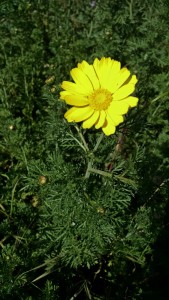It’s the first day back at the Baldwin Hills Scenic Overlook, but this time I’m a Celebrate Shorebirds Intern. At this site, LA Audubon workers (Carlos Jauregui, Brian Young, and Bryan Payes) and I manage restoration sites plotted across the park. We usually have walkers of the park question what we are doing and some look like they want to ask but are afraid to. So I want to take the opportunity and let the public know.
It’s nearly Springtime and flowers are popping up like popcorn! You may see us weeding a yellow flowering plant that may look pretty, but looks can be deceiving. The Garland/Chrysanthemum (Glebionis coronaria), is non-native and invasive! Picture below.

But wait! Don’t confuse it with our native California bush sunflower (Encilia californica). Both of the plants are in the Asteraceae family-the Sunflower family. The flowers in this family are composed of ray florets and disk florets. The disk florets are small flowers that make up the center of the flower. Next time you look at an asteraceae plant (such as the sunflower) look closely at the middle, those are all tiny flowers! The ray florets are petal-like and surround the disk florets. Here is a picture of the California bush sunflower.

One of the main differences between the Chrysanthemum and the California bush sunflower is the color of the center. The Chrysanthemum has a yellow center while the California bush sunflower is brown. Also, the California bush sunflower has “rounded diamond shaped leaves” while the Chrysanthemum has “pinnately lobed leaves”. Give the previous pictures a second look!
Now, time for discussion questions
What is the point of removing invasive plants such as the Chrysanthemum? Do you think it may have an impact on the vegetation in which it is growing in? Why or why not? Email me your answers at emilycobar@gmail.com
Day 2: Practice Survey with former LA intern, Carlos Jauregui
I’d like to thank Carlos for guiding me through this practice survey. I applied the skills that were developed throughout the training: identifying by shape and size, bills, and behavior; using the field guide; counting the flocks, etc! Carlos confirmed about 90% of my bird identifications so we had a successful practice survey 🙂
While we were surveying, look what we found growing across the creek! Can you identify this plant through the picture?
 )
)
If you said Chrysanthemum, give yourself a pat in the back- you are correct! We can identify it by its yellow center!
These were my highlights from week one and I’m excited to begin the shorebird survey protocols and to also use the outreach skills acquired from the training!